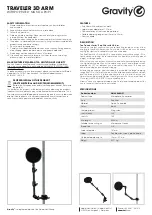
User Manual
7
7.
Installation
7.1
Orientation
The probe rods can be inserted vertically into the soil surface or buried at
any orientation to the surface. A probe inserted vertically into a soil
surface will give an indication of the water content in the upper 30 cm of
soil. The probe can be installed horizontal to the surface to detect the
passing of wetting fronts or other vertical water fluxes. A probe installed
at an angle of 30 degrees with the surface will give an indication of the
water content of the upper 15 cm of soil.
7.2
Potential Problems with Improper Insertion
The method used for probe installation can affect the accuracy of the
measurement. The probe rods should be kept as close to parallel as
possible when installed to maintain the design wave guide geometry. The
sensitivity of this measurement is greater in the regions closest to the rod
surface than at distances away from the surface. Probes inserted in a
manner which generates air voids around the rods will reduce the
measurement accuracy. In most soils, the soil structure will recover from
the disturbance during probe insertion.
In some applications, installation can be improved by using the CS650G
insertion guide tool. The CS650G is inserted into the soil and then
removed. This makes proper installation of the water content reflectometer
easier in dense or rocky soils.
7.3
Wiring
Table 7-1. Datalogger/Reflectometer Wiring.
Colour
Function
Datalogger Connection
red
+12 V
+12 V
green
output
SE analogue or universal
channel
orange
enable
control port
black
signal ground
⏚
or AG
clear
power ground
G
Both the black and clear wires must be grounded as shown in
Table
7-1
.
NOTE
















































